You are here
Ostiense - Garbatella - S.Paolo
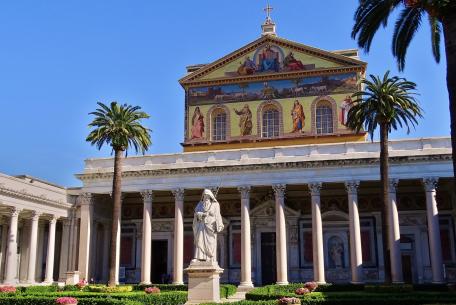
With its imposing structure, the Basilica of St. Paul Outside the Walls is one of the four papal basilicas of Rome, the second largest basilica after St.
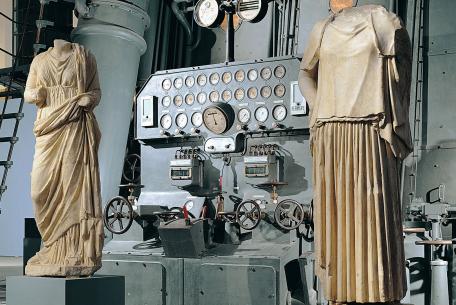
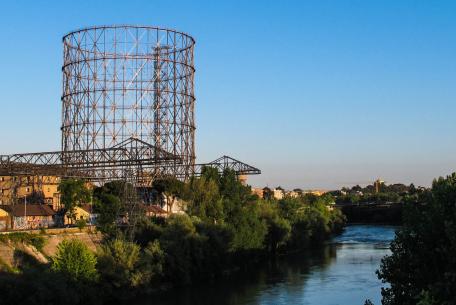
A colossal iron structure that is almost 90 meters in height and with a diameter of 63 meters, nicknamed for its monumentality the “Industrial Colosseum” or “Moder
[...]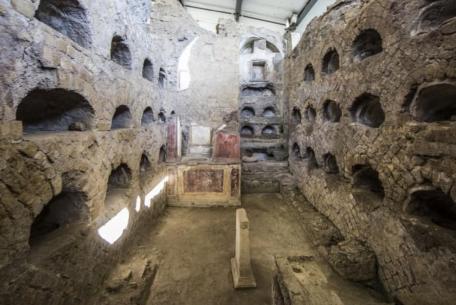
Between the Rupe di San Paolo and the bend of the Tiber was a vast burial groun
[...]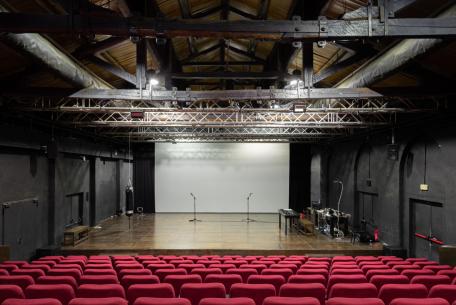
Always looking for new spaces in which to represent contemporary scenic forms, 20th-century theatre has often found its precise location within buildings of industrial arch
[...]An interesting mix of industrial archaeology and popular tradition is the main feature of Ostiense, one of the youngest and liveliest areas of the Capital. Its metropolitan-charm streets, captured by Ferzan Özpetek in the famous movie The ignorant fairies, are a reference point of the Roman nightlife, loved by international youth for its creative cuisine restaurants, characteristic bistros, live music venues and trendy nightclubs.
The neighbourhood stands out for the numerous Street Art works that decorate buildings, warehouses, and former industrial structures. Among them: Hunting Pollution by Iena Cruz, in via del Porto Fluviale, made with a particular paint that purifies the air; Black & White Power by Sten & Lex, in via dei Magazzini Generali, depicting a series of local imaginary residents; opposite, the Wall of Fame by JB Rock, faces of famous characters from A to Z - such as Dante Alighieri, Jimi Hendricks, Frida Khalo and Elvis - along with those of some of his family.
Ostiense is located in the south of the city near the Tiber. It takes its current shape at the beginning of the 20th century, when the then-mayor of Rome, Ernesto Nathan, starts the construction of a new area with an industrial vocation. By the end of the 19th century, a modern slaughterhouse was already built in the nearby Rione Testaccio. In operation until 1975, it is today a cultural centre dedicated to the contemporary. The extension works of the Via Ostiense to the sea also began, then completed in 1907.
Therefore, the General Markets were built, inaugurated in 1921, the new River Port for the landing of boats used for the transport of raw materials, the Gas Plant, with the 1936 large gasometer, then subjected to architectural constraints, and the Centrale Montemartini, the first electricity production public plant. This latter has been converted into a museum of ancient Roman art and is today the second exhibition centre of the Capitoline Museums. It contains a considerable collection of classical sculptures from the excavations carried out in Rome between the end of the 19th century and the beginning of the 20th. Along with the municipal structures, private establishments were built, including the General Warehouses for good storage, dairies, pasta, glass and hardware factories.
A short distance away, you reach the Garbatella, a human scale neighbourhood with a strong personality, born in the 1920s with the name of Concordia and made famous by Nanni Moretti's Vespa rides in the movie Dear Diary. The atmosphere is that of a small out-of-time village, built on the model of English garden cities, with houses in lots for the workers of the Via Ostiense factories.
It is the ideal place for a pleasant walk, thanks to the eclectic mix of architectural styles, ranging from Roman baroque to rationalism-futurism. Here, you can discover small shops, charming villas, and historic places. Not to be missed a look at the Suburban Hotels - colourful buildings that housed displaced families at the end of the war - or the former Palladium cinema, inspired by ancient Roman architecture, now a theatre.
If you are in the mood for a bit of archaeology, you can find out a stretch of the ancient via delle Sette Chiese; the street is linked to the famous Jubilee churches pilgrimage. Or you can discover the Catacombs of Commodilla, which kept the crypt with the tombs of the martyrs Felice and Adautto, some Byzantine paintings and a 9th-century AD curious graffiti inscription.
Between Via Ostiense and the Tiber is one of the four papal basilicas of Rome and the second largest one after St. Peter’s. We are talking about the splendid Basilica of St. Paul Outside the Walls. It was rebuilt between 1825 and 1854, after the devastating fire in 1823.
The facade with 17th-century mosaics introduces the magnificent interior, divided into five naves by eighty monolithic granite columns, with mosaics on the walls depicting portraits of popes. The outdoor is a peaceful place of charming beauty. The cloister is a 13th-century wonder; the monastic garden is a beautiful oasis ideally reproducing the biblical Eden. Here, in the Hortus simplicium, according to the millenary Benedictine tradition, the monks grow the medical plants.
For a relaxing break among the greenery, in front of the Basilica is Schuster Park. It is a game of geometric flower beds, crossed by an avenue and embellished by a grove of palm trees, a fountain and a large flowerbed of red roses. In the garden is the Steel Forest, the monument in memory of the fallen of Nassiriya, made up of 19 solid steel menhir. Each of them is 4 meters high and weighs 8 tons. Here is also the Sepolcreto Ostiense, a remarkable testimony on Roman funerary rites dated to the 2nd-3rd century AD.











































